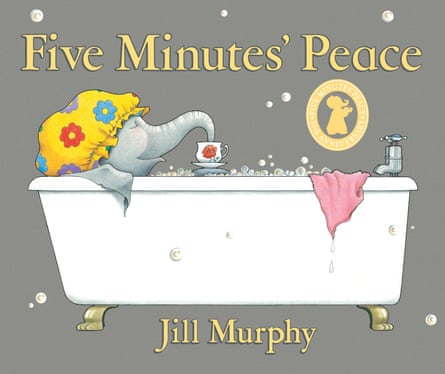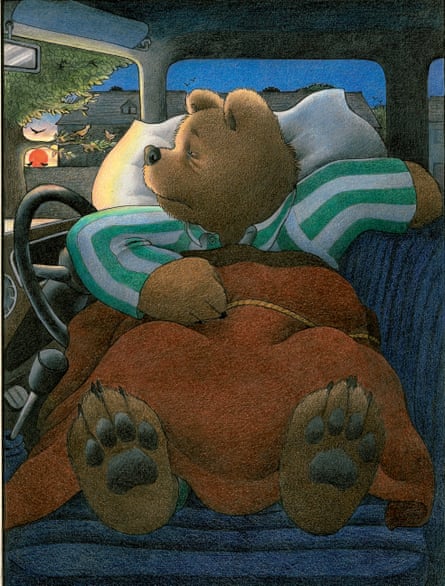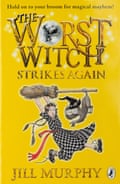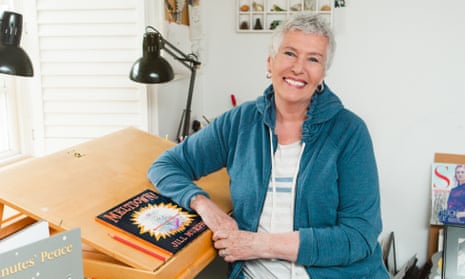The children’s author and illustrator Jill Murphy, who has died of cancer aged 72, was loved across generations for picture books that capture the essence of childhood in a realistic yet magical way.
Her career began at the age of 24 when her first book, The Worst Witch (1974), was published. An immediate success, it has consistently been on every list of top recommendations for seven-year-olds ever since. Equally successful have been her picture books about the everyday life of both the Bear family in Peace at Last in 1980 and the Large family in Five Minutes’ Peace in 1986. They and their sequels have been go-to books for children and parents alike with their humorous interpretations of the trials of parenthood.
Jill’s creative output was hugely successful both commercially and in terms of critical acclaim. She wrote and illustrated more than 20 picture books and 10 novels, including eight in The Worst Witch series. She was a bestseller internationally – sales of her books about the Large family were more than 5m – and she won several UK illustration awards.
Her skilfully crafted storytelling and the timelessness of her stories were such that they were repeatedly adapted for film, TV and for the stage. Most recently were a new TV adaptation of The Worst Witch (2017) as well as, in 2019, a stage version, winner of the best family show Olivier award, and an opera version of Peace at Last for three-to-five-year-olds.

In words and pictures, Jill’s stories have an easy and natural appeal to children. She liked children and all the warmth and mess of family life. Her stories about the Bear family and the family of elephants with the unsubtle surname Large, which they wear with pride, reflect that.
While the characters are animals the situations are entirely human and her stories are full of understanding and sympathy for parents as well as children. Neither judgmental not soppy they reflect reality as they revolve around easily recognisable situations. Father Bear’s search to find a quiet place to sleep in Peace at Last and Mrs Large’s need to find time for herself in Five Minutes’ Peace (1986) are both wonderfully sympathetic to some of the familiar and rather tougher parental situations.
More child-centred is the playful and imaginary adventure Whatever Next! (1983), in which Baby Bear turns a cardboard box into a rocket and whooshes up the chimney.
In her words and especially in her comfortingly detailed yet stylish illustrations, Jill’s stories were full of humour, imagination and a sense of play.
Much of her success lay in her confidence to create stories that avoided obvious messaging and to present them without making any judgments: parents are not cross when they cannot sleep or have time to themselves, nor are they failures. It is just one of those things that happens. Even in The Last Noo-Noo (1995), which is unusual in having an obvious purpose as Marlon’s granny does everything in her power to get him to give up his dummy, Jill’s subversion and humorous illustrations dilute any sense of message and enable it to avoid feeling like a book created to solve a situation.

Pamela Todd, Jill’s agent and friend, summed her up as “a natural, unstoppable storyteller with a formidable memory and eye for the kind of small, telling detail which made whatever she was recounting ring with recognition and zing with humour.”
Jill loved meeting children and was a keen visitor to schools. She was also generous with time in her replies to children who wanted to know about her work and life.
When asked where her stories came from, she always said that she did not need to search for stories: everything she wrote about came from within her. That was truest in The Worst Witch, which she wrote while still at school and finished while still in her teens.
For the creation of new girl Mildred Hubble and the way she did not fit in, and particularly for the strict structure of the school and the disagreeable character of the teacher Miss Hardbroom, Jill drew directly on her own experiences at the Ursuline Convent school, in Wimbledon, south-west London, where she was sent when she was 11. It was an academic school where, as Jill described it, she was “unpigeonholeable”.
With the addition of Jill’s magic touches, Miss Cackle’s Academy became the setting for the perfect magic school story and for Mildred herself, the schoolgirl millions of readers across the years have identified with.
Jill sent The Worst Witch to three publishers who turned it down. When Jill met the young founders of publishers Allison & Busby they took a chance on the manuscript and published it to an enthusiastic response from critics and readers alike. Jill revisited Mildred’s school career in several sequels and finished it with a glorious ending for her in First Prize for the Worst Witch (2018).

Born in London, Jill grew up in Chessington, which was then in Surrey, the daughter of Reeney (Irene) and Eric Murphy. Her father, who worked in an aircraft factory, had a talent for drawing that he shared with Jill, regularly slipping illustrated notes into her school lunchbox. Her mother, previously a librarian in the Harrods lending library, had wanted to be a writer and did much to encourage Jill.
She began making her first books when she was six and had created a library of handmade books to share with her friends by the time she was 11. Successful at her primary school, Jill floundered at secondary school and left at 16 to do art foundation courses at Chelsea then Croydon art schools, before moving to Camberwell School of Art, where she lasted only a term.
On leaving she worked as a nanny for a year and in children’s homes for four years, an environment that she loved.
Jill saw herself primarily as a writer. “I always write the story first. The illustrations really just tell the story in pictures, so you can’t do the pictures until you have a story to illustrate!” she told children who asked. She also admitted to children that having her books in libraries and bookshops was a dream come true.
The strikingly stylish and mildly magical air Jill had about her when she was first a successful author never left her. Throughout her career she inspired huge respect and affection across the children’s book world and beyond.
Jill, who settled in Cornwall, was first diagnosed with breast cancer aged 46. It recurred in 2015. She was married and divorced twice, first to Peter Wilks and then Roger Michell. She is survived by her son, Charlie, from her second marriage.

Comments (…)
Sign in or create your Guardian account to join the discussion